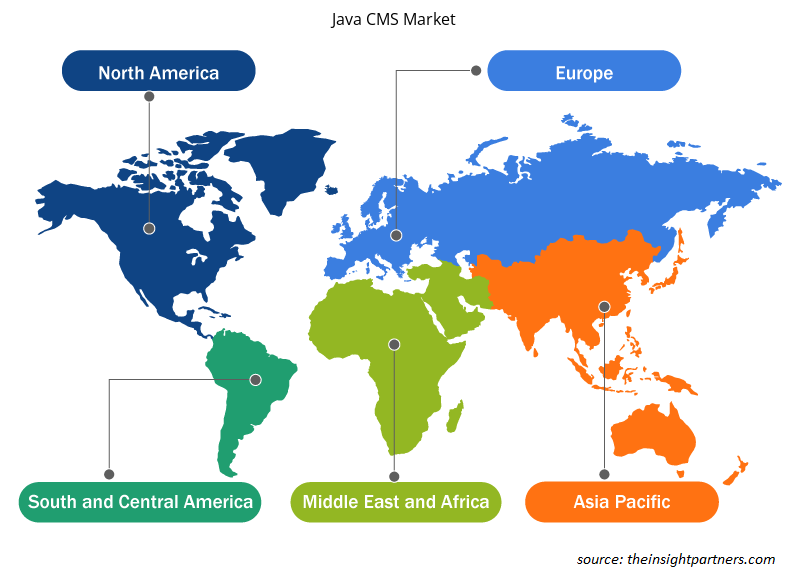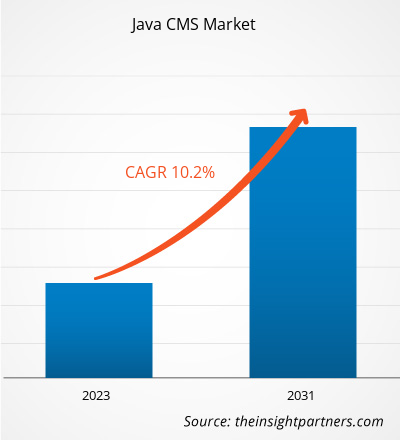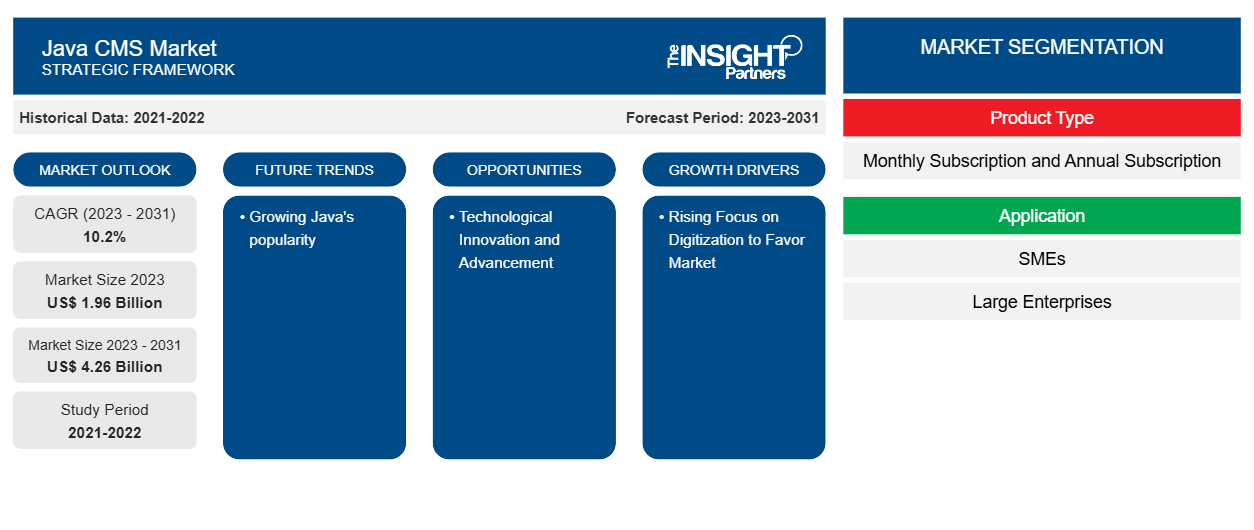Der globale Java-CMS-Markt soll von 1,96 Milliarden US-Dollar im Jahr 2023 auf 4,26 Milliarden US-Dollar im Jahr 2031 wachsen; von 2023 bis 2031 wird eine durchschnittliche jährliche Wachstumsrate von 10,2 % erwartet. Die wachsende Popularität von Java wird auf seine Robustheit, Zuverlässigkeit und Fähigkeit zurückgeführt, auf mehreren Plattformen zu laufen, und wird wahrscheinlich auch weiterhin ein wichtiger Trend auf dem Java-CMS-Markt bleiben.CMS market size is expected to grow from US$ 1.96 billion in 2023 to US$ 4.26 billion by 2031; it is anticipated to expand at a CAGR of 10.2% from 2023 to 2031. The growing Java popularity is attributed to its robustness, reliability, and ability to run on multiple platforms are likely to remain a key Java CMS market trends.
Java CMS Marktanalyse
Unternehmen aus verschiedenen Branchen konzentrieren sich zunehmend auf die Digitalisierung. Die Einführung digitaler Technologien und Lösungen ist für Unternehmen unerlässlich, um auf dem modernen Markt wettbewerbsfähig zu bleiben, was einer der Hauptfaktoren ist, die den Java CMS-Markt antreiben.
Java CMS Marktübersicht
Java Content Management System (CMS)-Software ist ein leistungsstarkes Tool, mit dem Unternehmen ihre Website-Inhalte effizient verwalten und aktualisieren können. Mit ihrer benutzerfreundlichen Oberfläche und ihren robusten Funktionen optimiert die Java CMS-Software den Prozess der Inhaltserstellung und -veröffentlichung, sodass Unternehmen problemlos eine dynamische Online-Präsenz aufrechterhalten können. Mit der Java CMS-Software können Unternehmen Webseiten erstellen und anpassen, Multimedia-Inhalte verwalten und die Sichtbarkeit in Suchmaschinen optimieren. Mit den intuitiven Workflow- Management- Funktionen können Teams bei der Inhaltserstellung und -veröffentlichung nahtlos zusammenarbeiten, was die Produktivität steigert und die Markteinführungszeit verkürzt.
Passen Sie diesen Bericht Ihren Anforderungen an
Sie erhalten kostenlose Anpassungen an jedem Bericht, einschließlich Teilen dieses Berichts oder einer Analyse auf Länderebene, eines Excel-Datenpakets sowie tolle Angebote und Rabatte für Start-ups und Universitäten.
- Holen Sie sich die wichtigsten Markttrends aus diesem Bericht.Dieses KOSTENLOSE Beispiel umfasst eine Datenanalyse von Markttrends bis hin zu Schätzungen und Prognosen.
Treiber und Chancen auf dem Java CMS-Markt
Zunehmender Fokus auf Digitalisierung begünstigt Markt
Die Digitalisierung spielt eine entscheidende Rolle für das Wachstum und den Erfolg von Unternehmen in verschiedenen Branchen. Durch die Einführung digitaler Technologien und Lösungen können Unternehmen digitale Inhalte effektiv verwalten und verteilen, was für die Wettbewerbsfähigkeit auf dem modernen Markt unerlässlich ist. Die Digitalisierung eröffnet Unternehmen neue Kommunikationskanäle. Durch digitale Technologien können Unternehmen mit Kunden in Kontakt treten und wertvolle Erkenntnisse gewinnen. Auf diese Weise können Unternehmen von ihren Kunden und Wettbewerbern lernen, was zu verbesserten Produkten und Dienstleistungen führt.
Technologische Innovation und Fortschritt
Technologische Innovation und Fortschritt spielen eine bedeutende Rolle bei der Förderung des Java CMS-Softwaremarktes. Kontinuierliche technologische Fortschritte optimieren die Leistung der Software und sorgen dafür, dass sie in nachgelagerten Anwendungen immer häufiger eingesetzt wird. Diese Fortschritte verbessern die Fähigkeiten der Java CMS-Software und tragen zu ihrem Wachstum bei. Darüber hinaus führt technologische Innovation zur Entwicklung benutzerfreundlicher Schnittstellen und intuitiver Arbeitsabläufe in der Java CMS- Software . Diese Verbesserungen verbessern das Benutzererlebnis und erleichtern den Benutzern die Navigation und Nutzung der Software.CMS Software market. Continuous advancements in technology optimize the performance of the software, making it more widely used in downstream applications. These advancements enhance the capabilities of Java CMS Software and contribute to its growth. Furthermore, technological innovation leads to the development of user-friendly interfaces and intuitive workflows in Java CMS
Segmentierungsanalyse des Java CMS-Marktberichts
Wichtige Segmente, die zur Ableitung der Java-CMS-Marktanalyse beigetragen haben, sind Produkttyp und Anwendung.
- Basierend auf dem Produkttyp ist der Markt in Monatsabonnements und Jahresabonnements unterteilt. Das Segment der Jahresabonnements hatte im Jahr 2023 einen größeren Marktanteil.
- Basierend auf der Anwendung ist der Markt in KMU und Großunternehmen unterteilt. Das Segment der Großunternehmen hatte im Jahr 2023 einen größeren Marktanteil.
Java CMS Marktanteilsanalyse nach Geografie
Der geografische Umfang des Java-CMS-Marktberichts ist hauptsächlich in fünf Regionen unterteilt: Nordamerika, Asien-Pazifik, Europa, Naher Osten und Afrika sowie Südamerika/Süd- und Mittelamerika. Nordamerika dominierte den Java-CMS-Markt im Jahr 2023. Die zunehmende Digitalisierung von Unternehmen und Organisationen in Nordamerika ist ein wesentlicher Treiber für den Java-CMS-Markt. Nordamerika ist die technologisch fortschrittlichste Region mit bedeutenden Volkswirtschaften wie den USA, Kanada und Mexiko. Kontinuierliche technologische Fortschritte und hohe Durchdringungsraten der Digitalisierung (~81 %) in der gesamten Region tragen zum Wachstum des Java-CMS-Softwaremarktes in Nordamerika bei.
Regionale Einblicke in den Java CMS-Markt
Die regionalen Trends und Faktoren, die den Java CMS-Markt im Prognosezeitraum beeinflussen, wurden von den Analysten von Insight Partners ausführlich erläutert. In diesem Abschnitt werden auch Java CMS-Marktsegmente und -Geografie in Nordamerika, Europa, im asiatisch-pazifischen Raum, im Nahen Osten und Afrika sowie in Süd- und Mittelamerika erörtert.

- Holen Sie sich regionale Daten zum Java CMS-Markt
Umfang des Java CMS-Marktberichts
| Berichtsattribut | Details |
|---|---|
| Marktgröße im Jahr 2023 | 1,96 Milliarden US-Dollar |
| Marktgröße bis 2031 | 4,26 Milliarden US-Dollar |
| Globale CAGR (2023 - 2031) | 10,2 % |
| Historische Daten | 2021-2022 |
| Prognosezeitraum | 2023–2031 |
| Abgedeckte Segmente | Nach Produkttyp
|
| Abgedeckte Regionen und Länder | Nordamerika
|
| Marktführer und wichtige Unternehmensprofile |
|
Marktteilnehmerdichte: Der Einfluss auf die Geschäftsdynamik
Der Java CMS-Markt wächst rasant, angetrieben durch die steigende Nachfrage der Endnutzer aufgrund von Faktoren wie sich entwickelnden Verbraucherpräferenzen, technologischen Fortschritten und einem größeren Bewusstsein für die Vorteile des Produkts. Mit steigender Nachfrage erweitern Unternehmen ihr Angebot, entwickeln Innovationen, um die Bedürfnisse der Verbraucher zu erfüllen, und nutzen neue Trends, was das Marktwachstum weiter ankurbelt.
Die Marktteilnehmerdichte bezieht sich auf die Verteilung der Firmen oder Unternehmen, die in einem bestimmten Markt oder einer bestimmten Branche tätig sind. Sie gibt an, wie viele Wettbewerber (Marktteilnehmer) in einem bestimmten Marktraum im Verhältnis zu seiner Größe oder seinem gesamten Marktwert präsent sind.
Die wichtigsten auf dem Java-CMS-Markt tätigen Unternehmen sind:
- Alkacon Software GmbH & Co. KG
- AMETYS
- Bloomreach Inc.
- IBM Corporation
- Gesellschaften, beginnend mit DOTC
- Crafter Software Corporation.
Haftungsausschluss : Die oben aufgeführten Unternehmen sind nicht in einer bestimmten Reihenfolge aufgeführt.

- Überblick über die wichtigsten Akteure auf dem Java CMS-Markt
Neuigkeiten und aktuelle Entwicklungen zum Java CMS-Markt
Der Java-CMS-Markt wird durch die Erfassung qualitativer und quantitativer Daten nach Primär- und Sekundärforschung bewertet, die wichtige Unternehmensveröffentlichungen, Verbandsdaten und Datenbanken umfasst. Im Folgenden finden Sie eine Liste der Entwicklungen auf dem Markt:
- Im September 2023 entwickelte das IBM-Ingenieurteam in Indien erfolgreich eine KI-Lösung, die die nahtlose Konvertierung von Cobol-Code in Java ermöglicht und Unternehmen damit ein leistungsstarkes Tool zur Modernisierung ihrer Softwaresysteme bietet.
(Quelle: IBM, Pressemitteilung, 2023)
Abdeckung und Ergebnisse des Java CMS-Marktberichts
Der Bericht „Java CMS-Marktgröße und -prognose (2021–2031)“ bietet eine detaillierte Analyse des Marktes, die die folgenden Bereiche abdeckt:
- Marktgröße und Prognose auf globaler, regionaler und Länderebene für alle wichtigen Marktsegmente, die im Rahmen des Projekts abgedeckt sind
- Marktdynamik wie Treiber, Beschränkungen und wichtige Chancen
- Wichtige Zukunftstrends
- Detaillierte PEST/Porters Five Forces- und SWOT-Analyse
- Globale und regionale Marktanalyse mit wichtigen Markttrends, wichtigen Akteuren, Vorschriften und aktuellen Marktentwicklungen
- Branchenlandschaft und Wettbewerbsanalyse, einschließlich Marktkonzentration, Heatmap-Analyse, prominenten Akteuren und aktuellen Entwicklungen
- Detaillierte Firmenprofile
- Historische Analyse (2 Jahre), Basisjahr, Prognose (7 Jahre) mit CAGR
- PEST- und SWOT-Analyse
- Marktgröße Wert/Volumen – Global, Regional, Land
- Branchen- und Wettbewerbslandschaft
- Excel-Datensatz
Aktuelle Berichte
Erfahrungsberichte
Grund zum Kauf
- Fundierte Entscheidungsfindung
- Marktdynamik verstehen
- Wettbewerbsanalyse
- Kundeneinblicke
- Marktprognosen
- Risikominimierung
- Strategische Planung
- Investitionsbegründung
- Identifizierung neuer Märkte
- Verbesserung von Marketingstrategien
- Steigerung der Betriebseffizienz
- Anpassung an regulatorische Trends





















 Kostenlose Probe anfordern für - Java CMS-Markt
Kostenlose Probe anfordern für - Java CMS-Markt